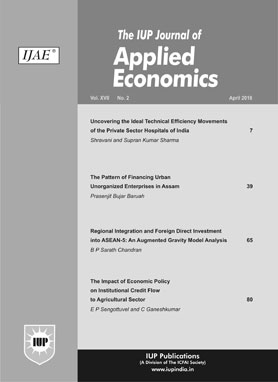
July' 23
The IUP Journal of Applied Economics
| Article | Price (₹) | ||
| Predicting and Validating the Impact of Energy Price Fluctuations on Food Inflation: A Machine Learning-Based Approach |
100
|
||
| Ownership and Financial Sustainability of Indian Oil and Gas Enterprises: An Orthogonal Deviation GMM Analysis |
100
|
||
|
Research Note Generational Coupling of Major Cryptocurrencies: An Empirical Evaluation |
100
|
||
|
Research Note Bitcoin Price Forecasting with Monte Carlo Simulations: Financial Stress Versus Market Attention |
100
|
||
Predicting and Validating the Impact of Energy Price Fluctuations on Food Inflation: A Machine Learning-Based Approach
Supply chain operations and the use of energy are inextricably interwoven. The supply chains, especially those operating in the food sector, which experience high competition, high implied demand uncertainty, low profit margin etc., are trying very hard to minimize their operational costs to become efficient in the marketplace. On the contrary, inflation has been one of the key issues in food supply chain operations. Irrespective of whether the food product is need-based or demand-based, inflation of essential commodities is experienced by consumers throughout the year. This paper examines how energy price fluctuations have impacted food supply chain prices in India. The time series data of energy and food resources have been modeled and validated using Machine Learning (ML)-based SARIMAX algorithm to find that High-Speed Diesel (HSD) impacts food inflation the most, keeping aside coal. In push-need-based food supply chains, the impact of HSD is relatively higher than in push-demand-based food supply chains.
Ownership and Financial Sustainability of Indian Oil and Gas Enterprises: An Orthogonal Deviation GMM Analysis
Although financial sustainability has attracted the attention of many researchers, the effect of ownership structure on financial sustainability has been understudied. In this paper we empirically investigate the relationship between ownership structure and financial sustainability of state-owned and private enterprises. We posit that by using debt for investments, the companies would be able to yield higher returns to their equity holders. Our measure of financial sustainability is return to equity holders. To check robustness, we assess return on assets. We use solvency ratios as our regressors. Data for this paper comes from 11 Indian oil and gas companies of which six are state-owned and five are private companies. The data is balanced panel data spread over 10 years during 2013-2022. We apply static Random Effects Model (REM) estimation and dynamic Generalized Method of Moments (GMM) model with orthogonal deviation. The results indicate differences in the effect on financial stability of state-owned and private companies.
Research Note Generational Coupling of Major Cryptocurrencies: An Empirical Evaluation
Despite the challenges faced bycryptocurrencies since their inception, theyhave emerged as the face of a new digitalage. Cryptocurrencies have gained popularitydue to their potential to disrupt the traditionalfinancial system, their security and privacyfeatures, accessibility, and growth potential.Among the three generations ofcryptocurrencies, Bitcoin, Ethereum, andCardano are the most traded, and dominatethe market by possessing more than half ofthe total share. Bitcoin is the pioneercryptocurrency invented by an anonymousentity named Satoshi Nakamoto. Accordingto Satoshi, Bitcoin is "a purely peer-to-peerversion of electronic cash that would allowonline payments to be sent directly from oneparty to another without going through afinancial institution" (Nakamoto, 2009).Ethereum is the second-biggest and mostpopular cryptocurrency (Malladi andDheeriya, 2021). It is labeled as the secondgenerationcryptocurrency as it inculcatedsophisticated technology allowing smartcontract capabilities (Sabalionis et al., 2021).Cardano was developed as the thirdgenerationcurrency as it attempted toaddress the unresolved issues of theethereum framework-scalability,interoperability, and sustainability-and wasdeveloped by a team of well-renownedacademicians and engineers based on ascientific philosophy (Robby, 2018).
Traditional financial models did not worksince cryptocurrency fundamentals differfrom corporate stocks, fiat currencies, orany other type of traditional financial asset,and there are also no price-to-earnings ratios,purchasing power parity, or interest rates tocompute value and future price forecasts.The lack of fundamentals and dominance ofindividual investors in the market reveal thatinvestor psychology and sentiments play akey role in the cryptocurrency market(Sabalionis et al., 2021). Some researchersrecommended pricing cryptocurrencies as anetwork rather than a financial asset, similarto how information transmission networksand social networks like Facebook are valued.In this context, it is assumed that the pricesof crypto coins influence each other.
Research Note
Bitcoin Price Forecasting with Monte Carlo Simulations: Financial Stress Versus Market Attention
The cryptocurrency market has attractedsignificant attention from academics,investors, and regulators due to its uniquecharacteristics. Research has shown that theprices and returns associated withcryptocurrency markets are volatile andunpredictable. As such, forecasting the futureprices of cryptocurrencies is of criticalimportance to investors (Nakamoto (2008).Two common methods used to forecastcryptocurrency prices are technical analysisand fundamental analysis. Stochastic modelsare widely used in economics and finance tomodel financial time series data such as stockreturns, exchange rates, and market indices.These models can be used to reproduce thepossible future prices observed in the marketand to discover future prices for a longhorizon. Several studies have developedeconometric methods to model the dynamicsof cryptocurrency. For example, Seasholesand Wu (2007) and Bandi and Reno (2016)highlighted the importance of consideringjumps when modeling bitcoin prices.
Multiple studies have corroborated thatcryptocurrency prices and return dynamicsare complex and extremely volatile (Hafner,2020; and Scaillet et al., 2020).Forecasting is the best way to explorethe future price of a stock (Omar and Jaffar,2014). Forecasting implies formingexpectations about what will happen in thefuture. Two common methods forforecasting stock prices rest on technicalanalysis theory and fundamental analysistheory (Fama, 1995). Fundamental analysisassumes that a stock's price depends on itsintrinsic value as well as its expected returns.